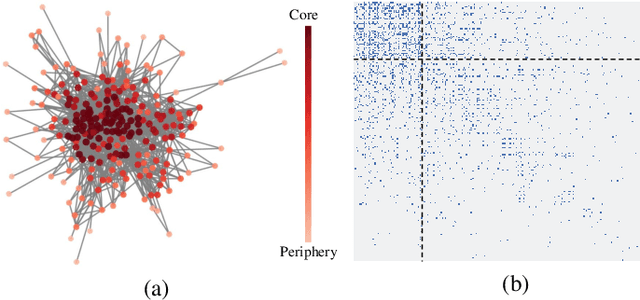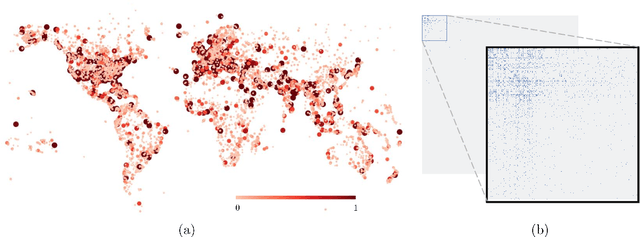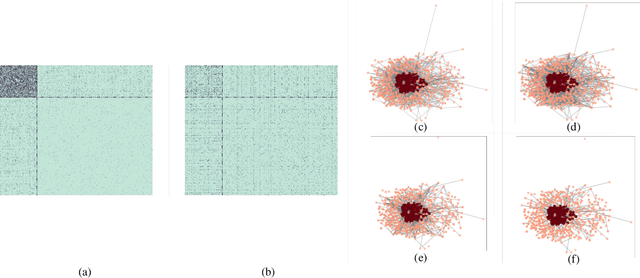Sundeep Prabhakar Chepuri
Sampling and Recovery of Signals on a Simplicial Complex using Neighbourhood Aggregation
Aug 18, 2023Abstract:In this work, we focus on sampling and recovery of signals over simplicial complexes. In particular, we subsample a simplicial signal of a certain order and focus on recovering multi-order bandlimited simplicial signals of one order higher and one order lower. To do so, we assume that the simplicial signal admits the Helmholtz decomposition that relates simplicial signals of these different orders. Next, we propose an aggregation sampling scheme for simplicial signals based on the Hodge Laplacian matrix and a simple least squares estimator for recovery. We also provide theoretical conditions on the number of aggregations and size of the sampling set required for faithful reconstruction as a function of the bandwidth of simplicial signals to be recovered. Numerical experiments are provided to show the effectiveness of the proposed method.
Coded Aperture Radar Imaging Using Reconfigurable Intelligent Surfaces
Aug 11, 2023
Abstract:In this paper, we focus on radar imaging using active sensing with a single transceiver and reconfigurable intelligent surface (RIS). RISs are arrays with tunable passive phase shifter elements that can modify the propagation channel. The RIS reflects each transmit pulse with a different phase profile. We use compressive sensing to recover the radar scene from observations at the single-antenna receiver. We also provide a projected gradient descent algorithm to design the RIS phase shifts to obtain minimally coherent observations required for recovery. Through numerical simulations, we demonstrate that the proposed method recovers radar scenes with point scatterers and extended targets.
Clustering with Simplicial Complexes
Mar 14, 2023



Abstract:In this work, we propose a new clustering algorithm to group nodes in networks based on second-order simplices (aka filled triangles) to leverage higher-order network interactions. We define a simplicial conductance function, which on minimizing, yields an optimal partition with a higher density of filled triangles within the set while the density of filled triangles is smaller across the sets. To this end, we propose a simplicial adjacency operator that captures the relation between the nodes through second-order simplices. This allows us to extend the well-known Cheeger inequality to cluster a simplicial complex. Then, leveraging the Cheeger inequality, we propose the simplicial spectral clustering algorithm. We report results from numerical experiments on synthetic and real-world network data to demonstrate the efficacy of the proposed approach.
Learning to Precode for Integrated Sensing and Communications Systems
Mar 11, 2023Abstract:In this paper, we present an unsupervised learning neural model to design transmit precoders for integrated sensing and communication (ISAC) systems to maximize the worst-case target illumination power while ensuring a minimum signal-to-interference-plus-noise ratio (SINR) for all the users. The problem of learning transmit precoders from uplink pilots and echoes can be viewed as a parameterized function estimation problem and we propose to learn this function using a neural network model. To learn the neural network parameters, we develop a novel loss function based on the first-order optimality conditions to incorporate the SINR and power constraints. Through numerical simulations, we demonstrate that the proposed method outperforms traditional optimization-based methods in presence of channel estimation errors while incurring lesser computational complexity and generalizing well across different channel conditions that were not shown during training.
Optimal Placement of Active and Passive Elements in Hybrid RIS-assisted Communication Systems
Jan 17, 2023Abstract:Hybrid reconfigurable intelligent surfaces (HRIS) are RIS architectures having both active and passive elements. The received signal-to-noise ratio (SNR) in HRIS-assisted communication systems depends on the placement of active elements. In this paper, we show that received SNR can be improved with a channel-aware placement of the active elements. We jointly design the transmit precoder, the RIS coefficients, and the location of active and passive elements of the HRIS to maximize the SNR. We solve the underlying combinatorial nonconvex optimization problem using alternating optimization and propose a low-complexity solver, which is provably nearly optimal. Through numerical simulations, we demonstrate that the proposed method offers significantly improved performance compared to communication systems having a fully passive RIS array or a hybrid RIS array with channel agnostic active element placement and performance comparable to that of communication systems with a fully active RIS array.
Quantized Precoding and RIS-Assisted Modulation for Integrated Sensing and Communications Systems
Nov 03, 2022

Abstract:In this paper, we present a novel reconfigurable intelligent surface (RIS)-assisted integrated sensing and communication (ISAC) system with 1-bit quantization at the ISAC base station. An RIS is introduced in the ISAC system to mitigate the effects of coarse quantization and to enable the co-existence between sensing and communication functionalities. Specifically, we design transmit precoder to obtain 1-bit sensing waveforms having a desired radiation pattern. The RIS phase shifts are then designed to modulate the 1-bit sensing waveform to transmit M-ary phase shift keying symbols to users. Through numerical simulations, we show that the proposed method offers significantly improved symbol error probabilities when compared to MIMO communication systems having quantized linear precoders, while still offering comparable sensing performance as that of unquantized sensing systems.
Integrated Sensing and Communications with Reconfigurable Intelligent Surfaces
Nov 02, 2022



Abstract:Integrated sensing and communications (ISAC) are envisioned to be an integral part of future wireless networks, especially when operating at the millimeter-wave (mmWave) and terahertz (THz) frequency bands. However, establishing wireless connections at these high frequencies is quite challenging, mainly due to the penetrating pathloss that prevents reliable communication and sensing. Another emerging technology for next-generation wireless systems is reconfigurable intelligent surfaces (RISs), which are capable of modifying harsh propagation environments. RISs are the focus of growing research and industrial attention, bringing forth the vision of smart and programmable signal propagation environments. In this article, we provide a tutorial-style overview of the applications and benefits of RISs for sensing functionalities in general, and for ISAC systems in particular. We highlight the potential advantages when fusing these two emerging technologies, and identify for the first time that: i) joint sensing and communications designs are most beneficial when the channels referring to these operations are coupled, and that ii) RISs offer means for controlling this beneficial coupling. The usefulness of RIS-aided ISAC goes beyond the individual obvious gains of each of these technologies in both performance and power efficiency. We also discuss the main signal processing challenges and future research directions which arise from the fusion of these two emerging technologies.
RIS-assisted Integrated Sensing and Communications: A Subspace Rotation Approach
Oct 23, 2022



Abstract:In this paper, we propose a novel joint active and passive beamforming approach for integrated sensing and communication (ISAC) transmission with assistance of reconfigurable intelligent surfaces (RISs) to simultaneously detect a target and communicate with a communication user. We first show that the sensing and communication (S&C) performance can be jointly improved due to the capability of the RISs to control the ISAC channel. In particular, we show that RISs can favourably enhance both the channel gain and the coupling degree of S&C channels by modifying the underlying subspaces. In light of this, we develop a heuristic algorithm that expands and rotates the S&C subspaces that is able to attain significantly improved ISAC performance. To verify the effectiveness of the subspace rotation scheme, we further provide a benchmark scheme which maximizes the signal-to-noise ratio (SNR) at the sensing receiver while guaranteeing the SNR at the communication user. Finally, numerical simulations are provided to validate the proposed approaches.
Generative Models and Learning Algorithms for Core-Periphery Structured Graphs
Oct 04, 2022



Abstract:We consider core-periphery structured graphs, which are graphs with a group of densely and sparsely connected nodes, respectively, referred to as core and periphery nodes. The so-called core score of a node is related to the likelihood of it being a core node. In this paper, we focus on learning the core scores of a graph from its node attributes and connectivity structure. To this end, we propose two classes of probabilistic graphical models: affine and nonlinear. First, we describe affine generative models to model the dependence of node attributes on its core scores, which determine the graph structure. Next, we discuss nonlinear generative models in which the partial correlations of node attributes influence the graph structure through latent core scores. We develop algorithms for inferring the model parameters and core scores of a graph when both the graph structure and node attributes are available. When only the node attributes of graphs are available, we jointly learn a core-periphery structured graph and its core scores. We provide results from numerical experiments on several synthetic and real-world datasets to demonstrate the efficacy of the developed models and algorithms.
Beamforming in Integrated Sensing and Communication Systems with Reconfigurable Intelligent Surfaces
Jun 15, 2022



Abstract:We consider transmit beamforming and reflection pattern design in reconfigurable intelligent surface (RIS)-assisted integrated sensing and communication (ISAC) systems to jointly precode communication symbols and radar waveforms. We treat two settings of multiple users and targets. In the first, we use a single RIS to enhance the communication performance of the ISAC system and design beams with good cross-correlation properties to match a desired beam pattern while guaranteeing a desired signal-to-interference plus noise ratio (SINR) for each user. In the second setting, we use two dedicated RISs to aid the ISAC system, wherein the beams are designed to maximize the worst-case target illumination power while guaranteeing a desired SINR for each user. We propose solvers based on alternating optimization as the design problems in both cases are non-convex optimization problems. Through a number of numerical simulations, we demonstrate the advantages of RIS-assisted ISAC systems. In particular, we show that the proposed single-RIS assisted ISAC system improves the minimum user SINR while suffering from a moderate loss in radar target illumination power. On the other hand, the dual-RIS assisted ISAC system improves both minimum user SINR as well as worst-case target illumination power at the targets, especially when the users and targets are not directly visible.
 Add to Chrome
Add to Chrome Add to Firefox
Add to Firefox Add to Edge
Add to Edge